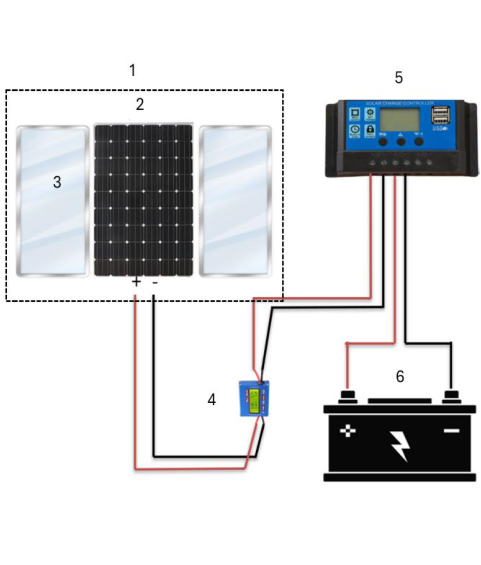Performance Enhancement of 100WP Monocrystalline Solar Panel using Mirror Reflectors

Downloads
This research analyzes how the reflection of sunlight intensity affects the power generated by a 100WP monocrystalline solar panel with the addition of various reflector tilt angles. An experimental method was used to conduct this analysis by comparing three tests: a solar panel without a reflector, with a 60° angled reflector, and with a 75° angled reflector. Data was collected at one-hour intervals from 09:00 to 16:00 WIB, measuring parameters such as temperature, intensity, voltage, current, and power. The results showed that the addition of a flat mirror reflector significantly improved the performance of the solar panel. With a 75° tilt angle, the total power generated was 373.32W, compared to the total power generated at 60° of 366.93W and without a reflector of 208.62W. The highest power peak was achieved at 13:00 WIB with the 75° reflector at 69.31W. This research demonstrates that a reflector tilt angle of 75° is the most optimal for increasing the efficiency of monocrystalline solar panels as it distributes sunlight more evenly across the panel surface. The recommendation for future research is the utilization of software-based simulations and IoT integration for real-time monitoring, to strengthen experimental data validation and expand the application of this technology at both industrial and household scales.
Downloads
[1] M. Usman, “Analisis Intensitas Cahaya Terhadap Energi Listrik Yang Dihasilkan Panel Surya,” Power Elektron. J. Orang Elektro, vol. 9, no. 2, pp. 52–57, 2020, doi: 10.30591/polektro.v9i2.2047.
[2] D. Hendrawati et al., “Design and Performance Evaluation of Analytic-Tuning Pid on Boost Converter for 200 Wp Photovoltaic,” J. Eng. Sci. Technol., vol. 18, no. 4, pp. 1–16, 2023.
[3] A. El Hammoumi, S. Chtita, S. Motahhir, and A. El Ghzizal, “Solar PV energy: From ma-terial to use, and the most commonly used techniques to maximize the power output of PV systems: A focus on solar trackers and floating solar panels,” Energy Reports, vol. 8, pp. 11992–12010, 2022, doi: 10.1016/j.egyr.2022.09.054.
[4] N. Novas, R. M. Garcia, J. M. Camacho, and A. Alcayde, Advances in solar energy to-wards efficient and sustainable energy, vol. 13, no. 11. 2021. doi: 10.3390/su13116295.
[5] A. K. Pandey et al., “Solar Energy Utilization Techniques, Policies, Potentials, Progresses, Challenges and Recommendations in ASEAN Countries,” Sustain., vol. 14, no. 18, pp. 1–26, 2022, doi: 10.3390/su141811193.
[6] B. W. Dionova, D. J. Vresdian, D. Nugraha, A. Janeul, A. Oktaviani, and M. N. Moham-med, “The Efficiency of MPPT in Mitigating the Effects of Partial Shading on Power Sta-bility through the MPNO Method,” vol. 1, 2025.
[7] L. Lubna, S. Sudarti, and Y. Yushardi, “Potensi Energi Surya Fotovoltaik Sebagai Sumber Energi Alternatif,” Pelita J. Penelit. dan Karya Ilm., vol. 21, no. 1, pp. 76–79, 2021, doi: 10.33592/pelita.v21i1.1269.
[8] B. W. Dionova, D. J. Vresdian, D. Nugraha, A. Janeul, A. Oktaviani, and M. N. Moham-med, “The Efficiency of MPPT in Mitigating the Effects of Partial Shading on Power Sta-bility through the MPNO Method,” J. Nas. Tek. Elektro, 2025.
[9] M. H. Abdel-Aziz et al., “Optimizing concentrated photovoltaic module efficiency using Nanofluid-Based cooling,” Energy Convers. Manag. X, vol. 26, no. January, 2025, doi: 10.1016/j.ecmx.2025.100928.
[10] B. W. Dionova, R. J. P. S, D. J. Vresdian, and L. P. Pratama, “Evaluation of 300 WP Solar Photovoltaic Panel Performance for Electric Vehicle Charging Station,” vol. 19, no. 03, pp. 80–84, 2023, [Online]. Available: http://dx.doi.org/10.32497/eksergi.v19i03.5008
[11] S. D. R. Asimul Alim, Hamid Abdillah, “Analisis Perbandingan Daya Keluaran Modul Solar Cell 50 WP Terhadap Penambahan Reflector Cermin Datar,” Vocat. Educ. Natl. Semin., vol. 01(01), pp. 110–115, 2022.
[12] T. Salameh, A. K. Hamid, M. M. Farag, and E. M. Abo-Zahhad, “Energy and exergy as-sessment for a University of Sharjah’s PV grid-connected system based on experimental for harsh terrestrial conditions,” Energy Reports, vol. 9, pp. 345–353, 2023, doi: 10.1016/j.egyr.2022.12.117.
[13] J. Gao, J. Luo, A. Xu, and J. Yu, “Light intensity intelligent control system research and design based on automobile sun visor of BH1750,” Proc. 29th Chinese Control Decis. Conf. CCDC 2017, pp. 3957–3960, 2017, doi: 10.1109/CCDC.2017.7979192.
[14] F. S. Dinniyah, W. Wahab, and M. Alif, “Simulation of Buck-Boost Converter for Solar Panels using PID Controller,” Energy Procedia, vol. 115, pp. 102–113, 2017, doi: 10.1016/j.egypro.2017.05.011.
[15] S. A. Kaban, M. Jafri, and Gusnawati, “Optimalisasi penerimaan Intensitas Cahaya Ma-tahari Pada Permukaan Panel Surya (Solar Cell) Menggunakan Cermin,” J. Fis., vol. 5, no. 2, pp. 108–117, 2020.
[16] I. Choulli et al., “An Analytical-Iterative Method for Accurate Parameter Estimation of the Single-Diode Model in Photovoltaic Modules: Application to Monocrystalline and Polycrystalline Modules under Various Environmental Conditions,” Green Energy Intell. Transp., p. 100285, 2025, doi: 10.1016/j.geits.2025.100285.
[17] A. Al Mansur et al., “Electrical experimental data collection of polycrystalline and mono-crystalline photovoltaic modules in an indoor environment using artificial sun simulator,” Data Br., vol. 43, 2022, doi: 10.1016/j.dib.2022.108389.
[18] A. Alim, H. Abdillah, and S. D. Ramdani, “Analisis perbandingan daya keluaran modul solar cell 50 WP terhadap penambahan reflector cermin datar,” Vocat. Educ. Natl. Semin., pp. 110–115, 2022.
[19] E. Fajrony, R. P. Aryasta, J. Napitupulu, J. M. Siburian, and J. Sinaga, “Analisa Energi Keluaran Modul Panel Surya Menggunakan Kaca Cermin Datar,” J. Teknol. Energi Uda J. Tek. Elektro, vol. 12, no. 2, p. 113, 2023, doi: 10.46930/jteu.v12i2.3677.
[20] A. Sumardiono, F. Hazrina, and A. Syaefulloh, “Perbandingan Nilai Daya Luaran Panel Surya Kapasitas 50Wp Terhadap Posisi Reflektor Cermin Datar,” Infotekmesin, vol. 14, no. 2, pp. 429–434, 2023, doi: 10.35970/infotekmesin.v14i2.1913.
[21] Isdawimah, N. Nadhiroh, Muchlishah, D. Monika, A. K. Wardhany, and A. B. Kusuman-ingtyas, “Pemanfaatan Reflektor Untuk Peningkatan Daya Luaran Panel Surya,” J. Poli-Teknologi, vol. 21, no. 3, pp. 97–106, 2022, doi: 10.32722/pt.v21i3.4723.
[22] B. Q. Sapian and N. H. Azhan, “Performance of Solar Photovoltaics Panel with the Pres-ence of Mirror Reflector at Different Angle,” Test Eng. Manag., vol. 83, no. April 2020, p. 8091, 2020.
[23] M. K. Kim, K. O. Abdulkadir, J. Liu, J. H. Choi, and H. Wen, “Optimal design strategy of a solar reflector combining photovoltaic panels to improve electricity output: A case study in Calgary, Canada,” Sustain., vol. 13, no. 11, 2021, doi: 10.3390/su13116115.
[24] M. Arslan and M. Çunkaş, “An experimental study on determination of optimal tilt and orientation angles in photovoltaic systems,” J. Eng. Res., no. July, 2024, doi: 10.1016/j.jer.2024.07.015.

This work is licensed under a Creative Commons Attribution-ShareAlike 4.0 International License.
The Authors submitting a manuscript do so on the understanding that if accepted for publication, copyright publishing of the article shall be assigned to Journal.



















